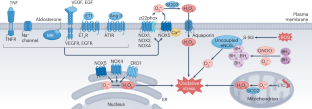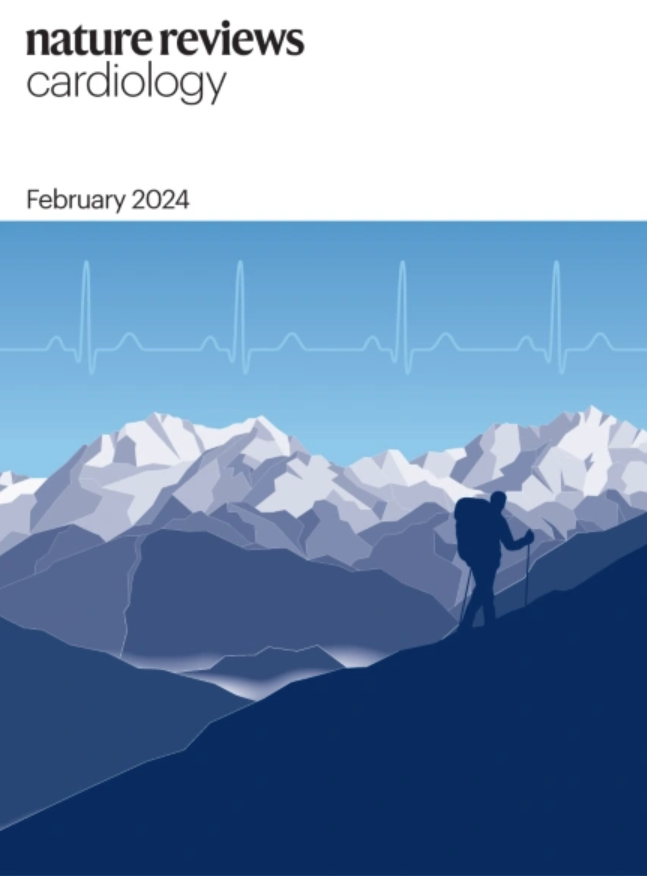高血压中的活性氧
IF 44.2
1区 医学
Q1 CARDIAC & CARDIOVASCULAR SYSTEMS
引用次数: 0
摘要
高血压是中风、心脏病和慢性肾病的主要危险因素。多种相互作用的因素和器官系统会使血压升高,并造成靶器官损伤。在高血压发病的众多分子因素中,活性氧(ROS)对导致血压升高的系统(如心血管、肾脏、免疫和中枢神经系统,或肾素-血管紧张素-醛固酮系统)的细胞过程产生影响。ROS 生成失调(氧化应激)是人类和实验模型中高血压的标志。在许多产生 ROS 的酶中,NADPH 氧化酶在高血压的发病中最为重要。在细胞层面,ROS 影响着决定细胞命运和功能的信号通路。氧化应激会促进氧化还原信号异常和细胞损伤,造成内皮功能障碍、血管损伤、心血管重塑、炎症和肾损伤,这些都是高血压的重要原因和后果。在几乎所有的高血压实验模型中,ROS 清除剂都能降低血压;然而,抗氧化剂的临床试验结果喜忧参半。在本综述中,我们将重点介绍在了解 ROS 在高血压中的作用和临床意义方面取得的最新进展。我们将重点关注 ROS 的细胞来源、氧化应激的分子机制、器官系统中氧化还原信号的改变及其对高血压的影响。本文章由计算机程序翻译,如有差异,请以英文原文为准。


Reactive oxygen species in hypertension
Hypertension is a leading risk factor for stroke, heart disease and chronic kidney disease. Multiple interacting factors and organ systems increase blood pressure and cause target-organ damage. Among the many molecular elements involved in the development of hypertension are reactive oxygen species (ROS), which influence cellular processes in systems that contribute to blood pressure elevation (such as the cardiovascular, renal, immune and central nervous systems, or the renin–angiotensin–aldosterone system). Dysregulated ROS production (oxidative stress) is a hallmark of hypertension in humans and experimental models. Of the many ROS-generating enzymes, NADPH oxidases are the most important in the development of hypertension. At the cellular level, ROS influence signalling pathways that define cell fate and function. Oxidative stress promotes aberrant redox signalling and cell injury, causing endothelial dysfunction, vascular damage, cardiovascular remodelling, inflammation and renal injury, which are all important in both the causes and consequences of hypertension. ROS scavengers reduce blood pressure in almost all experimental models of hypertension; however, clinical trials of antioxidants have yielded mixed results. In this Review, we highlight the latest advances in the understanding of the role and the clinical implications of ROS in hypertension. We focus on cellular sources of ROS, molecular mechanisms of oxidative stress and alterations in redox signalling in organ systems, and their contributions to hypertension. In this Review, Touyz and colleagues discuss the role of reactive oxygen species in the pathophysiology of hypertension, focusing on the mechanisms of reactive oxygen species generation and oxidative stress in hypertension, as well as the alterations in redox signalling. They also discuss potential therapeutic strategies for targeting oxidative stress in hypertension.
求助全文
通过发布文献求助,成功后即可免费获取论文全文。
去求助
来源期刊

Nature Reviews Cardiology
医学-心血管系统
CiteScore
53.10
自引率
0.60%
发文量
143
审稿时长
6-12 weeks
期刊介绍:
Nature Reviews Cardiology aims to be the go-to source for reviews and commentaries in the scientific and clinical communities it serves. Focused on providing authoritative and accessible articles enriched with clear figures and tables, the journal strives to offer unparalleled service to authors, referees, and readers, maximizing the usefulness and impact of each publication. It covers a broad range of content types, including Research Highlights, Comments, News & Views, Reviews, Consensus Statements, and Perspectives, catering to practising cardiologists and cardiovascular research scientists. Authored by renowned clinicians, academics, and researchers, the content targets readers in the biological and medical sciences, ensuring accessibility across various disciplines. In-depth Reviews offer up-to-date information, while Consensus Statements provide evidence-based recommendations. Perspectives and News & Views present topical discussions and opinions, and the Research Highlights section filters primary research from cardiovascular and general medical journals. As part of the Nature Reviews portfolio, Nature Reviews Cardiology maintains high standards and a wide reach.
 求助内容:
求助内容: 应助结果提醒方式:
应助结果提醒方式:


